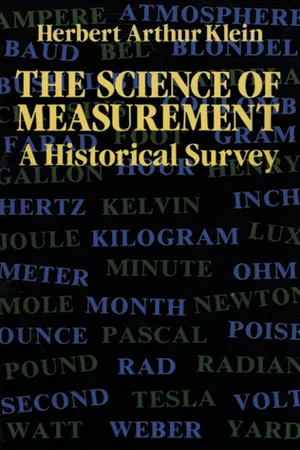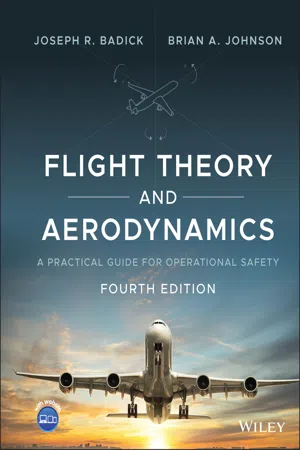Technology & Engineering
Mach Number
The Mach number is a dimensionless quantity that represents the speed of an object in a fluid, such as air or water, compared to the speed of sound in that fluid. It is named after Austrian physicist and philosopher Ernst Mach. A Mach number of 1 indicates that the object is traveling at the speed of sound.
Written by Perlego with AI-assistance
Related key terms
Related key terms
1 of 4
Related key terms
1 of 3
5 Key excerpts on "Mach Number"
- eBook - ePub
The Science of Measurement
A Historical Survey
- Herbert Arthur Klein(Author)
- 2012(Publication Date)
- Dover Publications(Publisher)
at the velocity of sound; at Mach 1.1 it moves 10 percent faster, and so on.This Mach Number is dimensionless (just as is the decibel), because it matters not a whit what system of units is used: the Mach Number will not be altered whether velocity is measured in meter per second, mile per hour, or furlong per fortnight.There are Mach Numbers for moving objects under water as well as for flying objects in the air and other gaseous media. When a plane exceeds a velocity of Mach 1, it is outstripping the sound waves that normally precede it and herald its approach to the ground and to other planes in the air. It pushes ahead of itself, by the sheer brute force of its jet thrust, a “shock wave.” The effects of this shock wave spread out to the ground, at the velocity of sound itself, through each layer of air down to terra firma.When a listener on the ground hears a plane flying at less than Mach 1 overhead, at each instant that its sound is audible he receives some sound energy which left the vicinity of the plane at a different time during its flight. Thus, the energy of sound that reaches a point on the ground is moderate and diluted, and somewhat extended in time.However, when a plane attains velocity of greater than Mach 1 in flight, there will be points or areas on the ground whose distance from the moving plane is diminishing at just the same rate (in meter per second or any other velocity measure) as the rate with which sound travels through that intervening air.The result is that sound energies that left the plane during an extended portion of its flight course all arrive at or near that one patch of the Earth’s surface at the same instant. The consequence is a huge, sudden hammer blow of pressure there. It is much like the way the total of energies added to a hammer during its downward swing are all focused on the head of the nail that it finally strikes. - Egbert Torenbeek, Peter Belobaba, Jonathan Cooper, Allan Seabridge(Authors)
- 2020(Publication Date)
- Wiley(Publisher)
More in‐depth treatments of aerodynamic phenomena around high‐speed flight vehicles to which attention must be paid in the aerodynamic design phase can be found in textbooks such as [ 4, 9 ], and [ 10 ]. 4.1.1 Speed of Sound and Mach Number An infinitesimal pressure disturbance such as a sound wave is transmitted in the atmosphere at the sonic (or acoustic) velocity. The propagation of sound is closely related to the transfer of momentum between colliding molecules, which depends on their average speed, whereas the average kinetic energy of molecules is proportional to the (local) temperature of the medium. The implication is that, according to the kinetic theory, the molecules of a gas are moving with an average velocity of, where and denote the gas constant and the temperature, respectively. It has been observed that the sonic velocity is about 75% of this value. A derivation based on the conservation equations of continuity, momentum and energy for isentropic flow through a stationary sound wave in a moving gas yields the following expression for the speed of sound: (4.1) where denotes the air density and the ratio of specific heat at constant pressure and volume. For atmospheric air, the gas constant amounts to J and the ratio of specific heat amounts to. Hence, it follows that the sonic velocity equals m and varies between 340 m at sea level and 295 m in the stratosphere. The most convenient index to assess whether the flow can be considered as incompressible is the Mach Number, defined as the ratio of the (local) flow velocity to the local sonic velocity. Present‐day high‐subsonic airliners are designed to travel at cruise Mach Numbers typically between and. In this flight regime aerodynamic effects such as shock waves, shock‐induced flow separation, and buffeting may occur associated with the compressibility of air- eBook - ePub
- Peter J. Swatton, Peter Belobaba, Jonathan Cooper, Roy Langton, Allan Seabridge(Authors)
- 2011(Publication Date)
- Wiley(Publisher)
(M FS). If the speed of the aeroplane is above the critical Mach Number (M CRIT) a shockwave may well form, even if the M FS is below Mach 1. b. Local Mach Number (M L). This is the ratio of the speed of the airflow at a point on the aeroplane to the speed of sound at the same point. c. Critical Mach Number (M CRIT). As M FS increases so do the local Mach Numbers. M CRIT is that M FS at which any M L has reached unity. It is the lowest speed in the transonic range. d. Critical Drag Rise Mach Number (M CDR). This is the M FS at which because of shockwaves, the C D for a given angle of attack increases significantly. e. Detachment Mach Number (M DET). This is the speed at which the bow shockwave of an accelerating aeroplane attaches to the leading edge of the wing or detaches if the aeroplane is decelerating. f. Indicated Mach Number. TAS is the difference between pitot pressure and static pressure. LSS is a function of static pressure and air density. Because air density is common to both TAS and LSS, both can be expressed as pressure ratios; this is what the Machmeter measures. Indicated Mach Number is therefore the ratio of the dynamic pressure to the static pressure. g. Shock Stall. The airflow over an aeroplane’s wings is disturbed when flying at or near the critical Mach Number. This causes the separation of the boundary layer from the upper surface of the wing behind the shockwave and is the shock stall, which is described in greater detail later in this chapter. h. The Speed of Sound (a). The speed of propagation of a very small pressure disturbance in a fluid in specified conditions. The local speed of sound through the air is equal to 38.94 multiplied by the square root of the absolute temperature (A) - eBook - ePub
Flight Theory and Aerodynamics
A Practical Guide for Operational Safety
- Joseph R. Badick, Brian A. Johnson(Authors)
- 2021(Publication Date)
- Wiley-Interscience(Publisher)
The speed of sound is an important factor in the study of high‐speed flight. Small pressure disturbances are caused by all parts of an aircraft as it moves through the air. These disturbances move outward from their source through the air at the speed of sound. A two‐dimensional analogy is that of the ripples on a pond that result when a stone is thrown in the water. The behavior of these disturbances changes at airspeeds near, at, and above the speed of sound, and these changes have profound effects on the flow of air over the wings of aircraft operating at these speeds.The speed of sound in air is a function of temperature alone, as can be shown in Eq. 14.1 . The speed of sound varies from 661 kts. at sea level on a standard day (15 °C) to 574 kts. at the tropopause (−56.5 °C); see Table 2.1 for the speed of sound at various altitudes on a standard day.(14.1)where- a = speed of sound in air
- a0 = speed of sound in air at sea level, standard day (661 kts.)
- θ = temperature ratio, T/T0
EXAMPLE
Calculate the speed of sound at a pressure altitude of 25 000 ft with an outside air temperature of −36 °C.Since Eq. 14.1 shows that the speed of sound is only a function of temperature, we can see that the higher in altitude the lower the speed of sound. Because the aircraft’s speed in relation to the speed of sound is so important in high‐speed flight, airspeeds are usually measured as Mach Number. Mach Number is the aircraft’s true airspeed divided by the speed of sound (in the same atmospheric conditions, i.e. local speed of sound):(14.2)where- M = Mach Number
- V = true airspeed (kts.)
- a = speed of sound (kts. local speed of sound)
EXAMPLE
Using the local speed of sound found in the last example, calculate the Mach Number if that same airplane has a velocity of 375 kts. TAS.When an aircraft is flying below the speed of sound, the pressure disturbances will be moving faster than the airplane (ripples on a pond), and those disturbances that travel ahead of the aircraft influence or “warn” the approaching airflow. This “pressure warning” can be observed in a smoke wind tunnel as it causes the upwash well ahead of the wing. This is shown in Figure 14.1 - eBook - ePub
Fly the Wing
A flight training handbook for transport category airplanes
- Billy Walker(Author)
- 2018(Publication Date)
- Aviation Supplies & Academics, Inc.(Publisher)
In summary, the true nature of compressibility is this: The greater the speed of a blunt object moving through the air, the greater the air density and air pressure directly in front of it, and the less smooth the flow of air around it. In an airstream flowing at a speed less than about three-tenths the speed of sound, Mach 0.3, the density changes of the air due to its compressibility can be ignored. However, above this speed, the density changes are large enough to affect the performance of the airplane and must be considered. In general, this effect acts as an aid to lift until the airstream on the wing’s surface exceeds the speed of sound. When this happens, compressibility effects begin to appear due to the creation of shock waves.It should be apparent that I am talking about the speed of an airstream and not the speed of an airplane. Remember that the speed of the air flowing over the wings of an airplane is greater than the speed of the plane itself. In fact, the speed of the air over the wings may be more than twice the speed of the plane at high angles of attack. For this reason, the air flowing over the wings may reach the speed of sound and form shock waves, even though the plane is flying at a speed well below the speed of sound. This is the reason that the limiting Mach Number of today’s aircraft is below the speed of sound, Mach 1.0.The limiting Mach Number is the maximum operating speed in relation to the speed of sound and is expressed as a percentage of the speed of sound. This limiting Mach, depending on your particular airplane, may be as low as Mach 0.75 or as high as Mach 0.90. Just remember, operation above that speed will subject you and your plane to all the bad features that may be expected from compressibility effects.Shock waves contribute greatly to compressibility effects, so a jet pilot should know something about them. There are several different types of shock waves—normal, oblique, and expansion—and each has its own characteristics. But there are three characteristics common to all shock waves:
Index pages curate the most relevant extracts from our library of academic textbooks. They’ve been created using an in-house natural language model (NLM), each adding context and meaning to key research topics.
Explore more topic indexes
Explore more topic indexes
1 of 6
Explore more topic indexes
1 of 4




